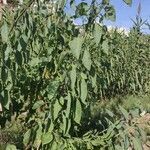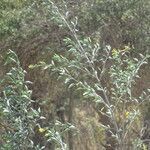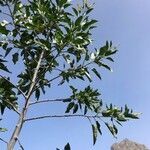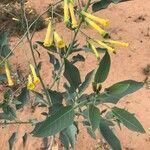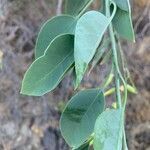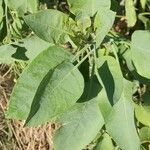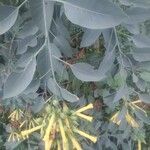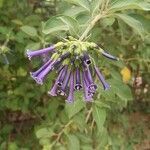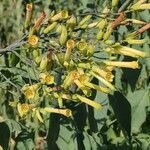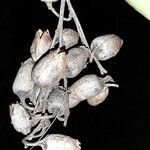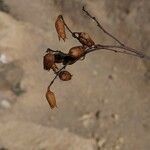Glabrous, glaucous, slender shrub or small tree, up to 5 m high. Stems green, brown, ± purple. Leaves broadly lanceolate, ovate to elliptic, up to 200 x 120 mm, margins entire; petioles up to 100 mm long. Flowers pendulous, in terminal and axillary racemes. Calyx ± 10 mm long. Corolla cylindrical, up to 40 mm long, ± widened above, under 10 mm in diam., lobes 3-4 mm long, yellow, ± pubescent outside. Fruit oblong-elliptical capsules, ± 15 mm long, ± brown, glabrous, splitting into 4 valves above, 2-loculed, in ± enlarged calyces. Seeds many, oblong, ± 0.5 mm long, finely reticulate, golden-brown. Flowering time all months, mainly Sept.-Nov.
Shrub 2-3-(6) m tall, glabrous except for fls. Petiole to 4-7 cm long, slender, unwinged. Lamina 3-8-(14) × 1-4-(9.5) cm (sometimes much larger in cultivation and on basal vegetative shoots), ovate-lanceolate, elliptic or obovate; base cuneate; apex acute or short-acuminate. Panicle open; fls to c. 20, not fragrant. Calyx 1-1.3 cm long; teeth 3-5 mm long, equal, triangular-acuminate, ciliate. Corolla 3.5-4 cm long, tubular, densely puberulent outside, yellow; lobes very shallow, c. 3 mm long, not reflexed, apiculate. Capsule c. 1 cm long, broadly ellipsoid. Seed 0.5-0.75 mm long, oblong, rugosely reticulate.
Corolla green, becoming yellowish or orangish, sometimes greenish at the apex of the lobes, (2.7)3–4(4.3) cm long, tubular-salviform; tube narrow to just above the calyx, then dilated and slightly broadened upwards, with a distinct swelling beneath the short limb, slightly constricted above and below the swelling, glabrous or minutely pubescent; limb 1.5–4 mm long, (3)4–8(10) mm across, nearly circular to nearly pentagonal in outline; lobes 0.5–1.2 × 2–3 mm, triangular-ovate, acute to rounded, erect to spreading.
Leaves solitary, glaucous to ± green; petiole 1–8.5(12.5) cm long, ± slender, not winged; lamina thickish, rubbery to softly leathery, 2–14(29.5) × 1–7(19) cm, broadly lanceolate, ovate to elliptic, sometimes obovate or spathulate, base attenuate, cuneate to rounded, truncate or subcordate, equal-sided to unequal-sided, apex acute to obtuse or rounded, sometimes apiculate or acuminate, entire or somewhat repand, both surfaces smooth, sometimes covered with a whitish waxy bloom.
Shrubs or small trees 2-6 m tall, glabrescent. Petiole slender, 3-12 cm; leaf blade ovate, 5-25 cm, leathery, base obtuse to cordate, entire, apex obtuse or acute, glaucous, subleathery. Inflorescences many-flowered, lax panicles. Pedicel 3-12 mm. Calyx tubular, 1-1.5 cm; lobes deltate, acute, equal. Corolla yellow to red, tubular, 2.5-4.5 cm; lobes short. Stamens subequal, included. Capsules ellipsoid, 0.7-1.5 cm. Seeds brown, ca. 0.5 mm.
Small tree or shrub, 3-9 m high. Stems and leaves glabrous, bluish green. Leaves petiolate; blade ovate to elliptic, up to 250 x 120 mm, margins entire; petioles up to 120 mm long. Flowers: in drooping clusters; corolla with tube 30-45 mm long, dilated above, 10 mm in diameter, somewhat contracted at mouth, limb narrow, shallowly and acutely lobed, yellow; Aug.-May. Fruit a brown, 4-valved capsule, ± 15 mm long.
Flowers erect to ± pendulous, in broad, flat, loose, paniculiform inflorescences 6–15 cm long, at the ends of the branches and in the axils below; bracts and bracteoles small, subulate, ephemeral; pedicels 5–10 mm long, slender, later markedly thickened distally, 11–14 mm long and incurved in fruit.
Small tree or shrub, 3-9 m high. Leaves and stems glabrous, glaucous. Leaves ovate to lanceolate, 50-250 mm long, distinctly petiolate. Corolla tube 30-45 mm long, dilated above, 10 mm across, somewhat contracted at mouth, limb narrow; shallowly and acutely lobed. Flowers yellow.
Calyx 8–13 × 3–5 mm, tubular, glabrous to shortly pubescent; teeth unequal to equal, 1.5–4 × 0.8–3 mm, triangular or ovate-triangular, acute or acuminate, somewhat ciliate, the membrane between them lacking or nearly so; in fruit somewhat enlarged to 14 × 9 mm and enclosing it.
Slender, poisonous shrub or small tree, up to 5 m tall, glabrous. Leaves petiolate, ± ovate, glaucous, up to 200 mm long. Flowers in racemes, yellow, calyx up to 10 mm long, corolla tubular, 35-40 mm long. Capsule ± 15 mm long, in ± enlarged calyces.
Stamens subequal or unequal, glabrous, included or rarely exserted; filaments 2–2.5 cm long, attached at the same level at or near the dilation of the corolla tube, geniculate just above the insertion; anthers 1.2–1.7 × 1–1.8 mm.
Virgate, rapidly growing, short-lived shrub or small tree, less often a herb, loosely few–much branched sometimes from the base, ± succulent, 2–6 m tall (elsewhere said to reach 10 m), mostly quite glabrous.
A shrub or small tree. It grows 2-6 m tall. The leaves are oval and 5-25 cm long. They are leathery. There are many flowers in a group. They are long and trumpet shaped and yellow. They hang down.
Fruit often pendulous, brownish, papyraceous or chartaceous, 8–12 × 5–8 mm, oblong-ellipsoid, glabrous, splitting above into 4 valves by septicidal and loculicidal slits.
Slender shrublet or small tree to 3 m. Leaves ovate-elliptic, long-petioled. Flowers in loose, terminal cymes, tubular, 35-40 mm long, yellow.
Disk 0.5–0.6 mm high, thick, quite coalescent to adnate upwards to the basal part of the ovary, obsoletely lobed to almost truncate.
Branches terete to angular, younger parts glaucous, greenish or blue-purplish, sometimes covered with a waxy bloom.
Seeds brown or golden-brown, 0.5 × 0.3 mm, prismatic, laterally compressed, honeycombed-reticulate.
Ovary 2.2–3 × 2 mm, conical, glabrous; style 3–3.5 cm long, straight.
